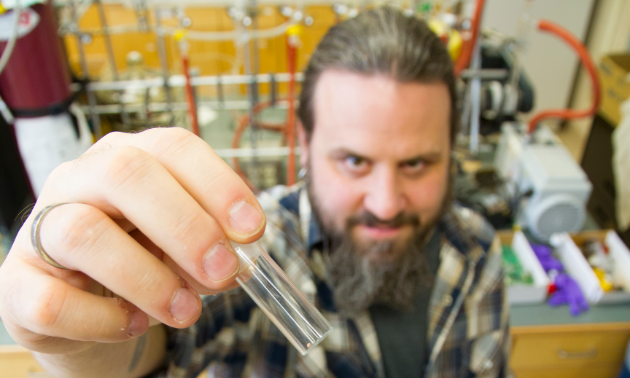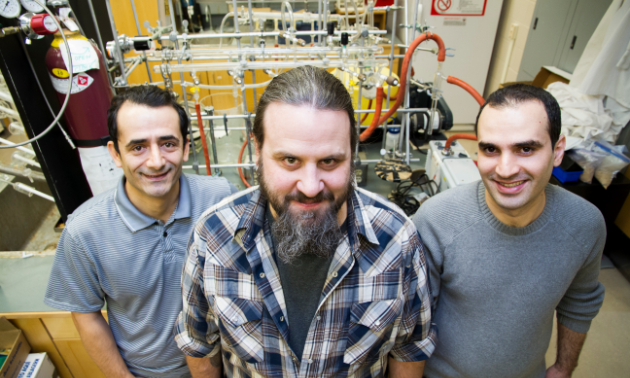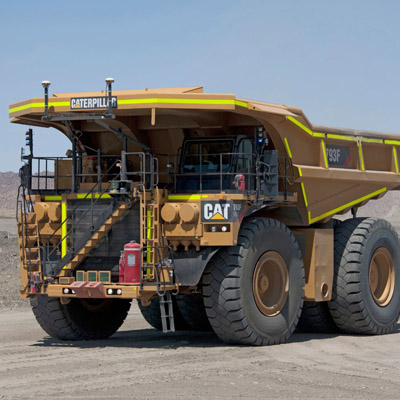The green way to extract gold
University of Saskatchewan chemists break new ground in both mining and recycling

Stephen Foley and his team discovered a greener way to extract gold that has potential applications in both the mining industry and the recycling process of electronic waste. — Photo courtesy University of Saskatchewan
Stephen Foley, a professor with a PhD in organic chemistry at the University of Saskatchewan, and his team, Hiwa Salimi and Loghman Moradi, first took a look at how the mining industry extracts gold three years ago. Their findings were surprising: “We looked at precious metals and gold in particular and were surprised to see that the core process in the mining industry—where they use cyanide to extract gold—hadn’t changed in 125 years,” Foley said. “Being from the University of Saskatchewan, and the province heavily involved in mining, we started to look at where we could make a contribution.”
Mining in Canada is, clearly, dominated by engineers. However, Foley and his team believed that there could be a place for chemists when revamping the core processes necessary to extract gold and other precious metals. “People have focused on using water-based systems, but the problem with water-based systems is that you need to use concentrated acid,” said Foley. The concentrated acid is usually a nasty chemical, like cyanide.
Over the years, engineers have tried to refine the current harmful process with no luck in terms of lessening the environmental impact. Rather than simply refining the outdated harmful processes of gold extraction in mining, the Saskatchewan team of chemists set out to create an entirely new, environmentally friendly—yet still economically feasible—system.
Their system targets the majority of gold mines in Canada: low-grade gold ore. These mines only have three grams of gold per ton of rock. Water mixed with chemicals was deemed the best route for extracting these miniscule amounts of gold because it is economically feasible, and water is abundant. “We tried to move away from water, while still using a solvent that is sustainable,” said Foley.
Their research led to the discovery of the gold-selective properties of concentrated acetic acid when used as a solvent. Diluted acetic acid is essential household vinegar—a seemingly simple fix to large problems in mining. When they added tiny amounts of an acid and an oxidant to their acetic acid, the system successfully acts in literally seconds. “We were surprised how fast it works,” said Foley. “On top of that, it’s selective for gold. It will dissolve gold from electronic waste and leave all of the other materials behind.”

The team of chemists from left to right: Loghman Moradi, Stephen Foley, and Hiwa Salimi. — Photo courtesy University of Saskatchewan
This is where the team turned their attention to gold recycling: specifically, the recovery of gold from electronic waste. Their findings show that these two industries have a notable similarity: in mining, the processes in place are far from environmentally friendly; recycling procedures are not much better.
“The majority of electronic waste, if it’s on a massive recycling capacity, is all done by pyrometallurgy. It’s all sent to smelters,” said Foley. “On a smaller scale, it’s all done by hydrometallurgy techniques. So an example of that would be aqua regia—a nasty acid that is used to extract gold.” These harmful systems of so-called recovery lead to unnecessary waste across the board. Foley’s team hopes to draw the attention away from pyro and hydrometallurgy, and towards their fast-acting, environmentally friendly and feasible system of acetic acid. All of the gold they recover from the waste can be reused to create new products.
The solvent itself is reusable, further minimizing the byproducts typical of electronic waste recycling procedures. “Only 100 litres of our system can process five tons of electronic waste, and all of that 100 litres can be recycled,” said Foley. “From an environmental standpoint, it takes a very small amount of solution to process a large amount of electronic waste.”
When bought in bulk, acetic acid is roughly 50 cents per litre. Given the price, speed of gold recovery and reusability of the solvent on the necessary scale, this new process may become the best solution for recycling electronics. However, to use this process in mining, Foley's team plans to consider larger scales. They need to develop an effective way to recycle the acetic acid in large amounts, so that it can be reapplied to extract more gold.
All of their tests have been completed in a laboratory setting. In order to truly understand the possibilities and limitations of their system, this University of Saskatchewan team needs to consider pilot plant projects. “We are ready to scale up,” Foley said. Larger-scale tests would allow this team of chemists to further optimize the green gold extraction process.
A few North American companies have already seen the value of their newly developed green gold extraction process: “We’ve had a couple mining companies approach us who are interested in the process" said Foley, "as well as some major e-waste producers that are looking at recycling the gold from electronics in-house.” Foley and his team invite interested parties to connect with them.




